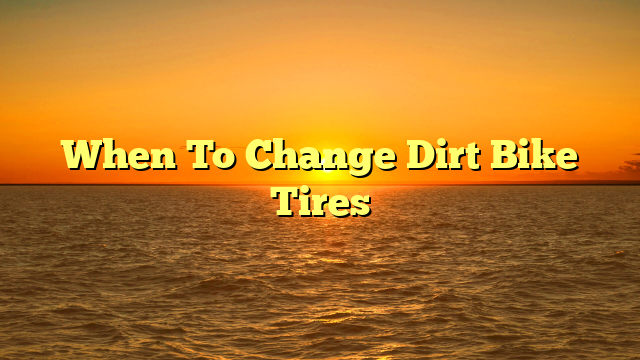As an avid mountain biker, I know how crucial it is to have properly functioning tires when hitting the trails.
Your tires are what keep you connected to the ground and allow you to navigate through a variety of terrains.
But how do you know when it’s time to replace your tires?
In this article, I will provide you with a detailed guide on when to replace your mountain bike tires, including signs of wear and tear, tread depth, riding style and terrain considerations, and frequency of use.
Not only is it important for your safety to have well-functioning tires, but it also impacts your overall performance and enjoyment on the trails.
By understanding when to replace your tires and how to choose the right replacement, you can ensure that you are getting the most out of your mountain biking experience.
So, let’s dive in and explore the world of mountain bike tires!
Table of Contents
- 1 Key Takeaways
- 2 The Importance of Properly Functioning Mountain Bike Tires
- 3 Signs of Wear and Tear on Your Tires
- 4 Inspecting Your Tires for Damage
- 5 Tread Depth and Its Impact on Performance
- 6 Riding Style and Terrain Considerations
- 7 Frequency of Use and Tire Lifespan
- 8 Choosing the Right Replacement Tires
- 9 Maintaining Your New Tires for Longevity and Performance
- 10 Frequently Asked Questions
- 10.1 Can I use road bike tires on my mountain bike?
- 10.2 Is there a specific tire pressure range that should be used for mountain biking?
- 10.3 Should I replace both tires at the same time, or can I replace just one?
- 10.4 Are there any alternative materials to traditional rubber tires for mountain bikes?
- 10.5 Can tubeless tires be used on all mountain bikes, or only certain models?
- 11 Conclusion
Key Takeaways
- Regularly inspect tires for signs of wear and tear, including low pressure, tire age, and tread pattern.
- Consider the terrain and riding style when selecting tire tread, as it affects performance in wet and rough conditions.
- Replace tires when wear indicators or cracks appear, or when they have reached the end of their lifespan.
- Choose replacement tires based on the terrain you will be riding on.
The Importance of Properly Functioning Mountain Bike Tires
You gotta make sure your mountain bike tires are working right, or else you’ll be in for a bumpy ride!
Proper inflation is crucial for the tire’s performance and longevity.
Overinflated tires will cause a harsh and uncomfortable ride, while underinflated tires can lead to pinch flats and decreased traction performance.
It’s important to check the recommended tire pressure, which can be found on the sidewall of the tire or in the owner’s manual, and use a reliable pressure gauge to ensure that the tires are properly inflated.
Traction performance is another critical factor in determining whether or not your mountain bike tires are working properly.
If your tires don’t have enough tread, you’ll have trouble keeping your bike on the trail.
Also, worn-out treads can affect braking and cornering performance.
Therefore, it’s important to inspect your tires regularly and replace them when the tread is worn down.
Don’t take any chances when it comes to your mountain bike tires, as they are the only contact point between you and the trail.
Signs of Wear and Tear on Your Tires
Spotting signs of wear and tear can help determine if it’s time for a fresh set of rubber.
Two important considerations are tire pressure and tire age.
Low tire pressure can lead to premature wear and an increased risk of punctures.
Checking the tire pressure regularly and inflating it to the manufacturer’s recommended level can help prolong the life of your tires.
Additionally, tires have a limited lifespan and should be replaced every few years, regardless of wear.
This is because the rubber can dry out and crack over time, increasing the risk of blowouts.
Another factor to consider is the tread pattern of your tires.
Different tread patterns are designed for different terrain and riding styles.
For example, aggressive, knobby treads are better suited for off-road riding, while smoother, low-profile treads are better for pavement or smooth trails.
When inspecting your tires for wear, pay attention to the tread depth and pattern.
If the tread is worn down or uneven, it may be time for a new set of tires.
Overall, regularly inspecting your tires and replacing them when necessary can help ensure a safe and enjoyable ride.
| Tire Pressure | Tire Age | Different Tread Patterns |
|---|---|---|
| Check regularly and inflate to recommended level | Replace every few years, regardless of wear | Choose based on terrain and riding style |
| Low pressure can lead to premature wear and punctures | Rubber can dry out and crack over time | Aggressive treads for off-road, low-profile for pavement |
| Check regularly and inflate to the recommended level | – | Check tread depth and pattern for wear |
Inspecting Your Tires for Damage
When inspecting for signs of wear and tear, it’s important to carefully examine your mountain bike tires for any potential damage.
There are different types of damage that you should be aware of, such as cuts, punctures, and sidewall damage.
If you notice any of these, it’s essential to determine whether it’s repairable or if it requires replacement.
Minor cuts and punctures can often be repaired using a tubeless tire repair kit.
However, if the damage is too severe or in the sidewall, it’s better to replace the tire altogether.
It’s also important to note that after a certain amount of wear and tear, the tread on your tire will become too worn down to provide adequate traction.
In this case, replacement is necessary to avoid any accidents or injuries while riding.
Ultimately, inspecting your tires for damage and determining whether it’s repairable or requires replacement is crucial for your safety and overall performance on the mountain bike trails.
Tread Depth and Its Impact on Performance
Having a deep tread on your tires can greatly enhance your performance while riding on challenging terrain.
A tire’s tread depth is the measurement of the distance between the top of the tread rubber to the bottom of the tire’s deepest grooves.
It’s important to consider tread depth when deciding whether to replace your mountain bike tires or not.
Here are some things to keep in mind:
- Improved Traction: Tread depth provides better grip and traction on various surfaces, especially loose or wet terrain.
This allows you to maintain control and stability while riding.
- Wet Weather Riding: In wet conditions, a deeper tread pattern helps channel water away from the tire, preventing hydroplaning and improving traction.
This is crucial when riding on slippery or muddy trails.
- Wear and Tear: Over time, the tread on your tires will naturally wear down, reducing its effectiveness and performance.
Therefore, it’s important to monitor the tread depth and replace your tires when it becomes too shallow.
- Terrain: The type of terrain you ride on also affects tread depth.
If you frequently ride on rocky or rough terrain, your tires may wear down faster than if you ride on smoother trails.
It’s important to select tires with appropriate tread patterns for your riding style and trail conditions.
Tread depth is an important factor to consider when deciding whether to replace your mountain bike tires or not.
A deeper tread pattern provides improved traction and grip on various surfaces, especially in wet conditions.
It’s important to monitor the wear and tear of your tires and replace them when needed to ensure optimal performance and safety while riding.
Riding Style and Terrain Considerations
To fully enjoy your ride, you’ll want to consider the terrain you’ll be riding on and your personal riding style.
When it comes to mountain biking, different terrains require different tire treads.
For example, if you’re planning to tackle some downhill challenges, you’ll want tires with wide knobs that provide an excellent grip on loose dirt and rocks.
On the other hand, if you’re more of a cross-country rider, you’ll want tires with smaller, closely spaced knobs that offer less rolling resistance and allow for faster speeds on smoother terrain.
Your personal riding style also plays a role in determining when to replace your mountain bike tires.
If you’re an aggressive rider who likes to take on technical terrain with plenty of drops and jumps, you’ll put your tires through more wear and tear than someone who sticks to flatter, smoother trails.
As a result, you may need to replace your tires more frequently.
Additionally, if you frequently ride in wet or muddy conditions, your tires will wear down faster than if you only ride in dry conditions.
So, to get the most out of your mountain bike tires, it’s important to take into account both the terrain you’ll be riding on and your personal riding style.
Frequency of Use and Tire Lifespan
If you ride your bike frequently and push it to its limits, you’ll eventually need to consider how long your tires will last.
Usage patterns play a significant role in determining when to replace mountain bike tires.
If you ride your bike on rough terrain with sharp rocks and roots, your tires will wear out more quickly than if you stick to smooth, even trails.
Additionally, if you frequently ride in wet conditions, your tires will wear out faster than if you only ride in dry weather.
One way to determine if it’s time to replace your tires is to look for wear indicators.
These are small notches on the surface of the tire that indicate when the rubber has worn down to a certain level.
If the wear indicators are visible, it’s time to replace your tires.
Another way to tell if your tires are worn out is to check for cracks in the rubber.
This is a sign that the rubber has become brittle and may not provide the grip you need on the trail.
By paying attention to usage patterns and wear indicators, you can ensure that you replace your mountain bike tires before they become a safety hazard.
Choosing the Right Replacement Tires
When you’re looking for new mountain bike tires, it’s crucial to consider the type of terrain you’ll be riding on and your personal riding style.
The right tire choice can make a significant difference in your riding experience.
For instance, if you’re a downhill rider, you’ll want tires with aggressive tread patterns that offer excellent grip and stability on steep and rocky descents.
On the other hand, if you’re more into cross-country riding, you’ll want tires that are lightweight, with low rolling resistance, and designed for speed.
When selecting replacement tires, pay attention to the tire types and sizes available.
Mountain bike tires come in various types, such as tubeless ready, tubeless, and traditional clincher.
Tubeless tires are popular among riders because they offer improved traction, reduced rolling resistance, and fewer chances of getting a flat.
Size selection is also critical when choosing new tires.
Your bike’s rims will determine the tire size you need, so make sure to check the tire’s compatibility before making a purchase.
Remember that the right tire choice can make a significant difference in your riding experience, so it’s worth taking the time to research and choose wisely.
Maintaining Your New Tires for Longevity and Performance
Properly maintaining your new tires is crucial for maximizing their longevity and performance, ensuring that you get the most out of your investment and your riding experience.
Here are some tips to help you keep your new mountain bike tires in tip-top shape:
- Proper Cleaning: Regularly cleaning your tires will help prevent dirt and debris from building up and potentially damaging the rubber.
Use a mild soap and water to clean the tires, but avoid using any harsh chemicals that could damage the rubber.
- Inflation Techniques: Properly inflating your tires is essential for optimal performance.
Check the recommended tire pressure for your specific tires and use a reliable tire gauge to ensure accurate inflation.
Underinflated tires can negatively affect your ride, while overinflated tires can risk punctures or blowouts.
- Storage Methods: When not in use, store your tires in a cool, dry place away from direct sunlight and extreme temperatures.
Keep them away from any sharp objects or chemicals that could damage the rubber.
- Tire Rotation: Regularly rotating your tires can help distribute the wear evenly, extending the life of your tires.
This is especially important if you frequently ride on rough terrain or use your bike for commuting.
Check the manufacturer’s recommendations for rotation frequency and direction.
Following these tips for proper cleaning, inflation techniques, storage methods, and tire rotation will help ensure that your new mountain bike tires perform at their best for as long as possible.
Remember that regular maintenance and care is key to getting the most out of your investment and your riding experience.
Frequently Asked Questions
Can I use road bike tires on my mountain bike?
No, road bike tires are not recommended for mountain bikes due to the different tread patterns.
Mountain bike tires have larger knobs to handle rough terrain, while road bike tires have smoother treads for faster riding.
Is there a specific tire pressure range that should be used for mountain biking?
When mountain biking, it’s important to adjust tire pressure based on terrain.
Lower pressure provides better traction and shock absorption on rough terrain.
Consult manufacturer guidelines for optimal pressure range.
Should I replace both tires at the same time, or can I replace just one?
It’s recommended to replace both tires at the same time to maintain optimal performance.
However, if only one is worn, it’s possible to replace just that tire.
Cost effective options include purchasing a tire with similar tread and size.
Are there any alternative materials to traditional rubber tires for mountain bikes?
I researched eco-friendly options for my mountain bike tires and discovered that there are alternatives to rubber, such as kevlar, that are more durable and resistant to punctures.
However, they can be more expensive and may affect ride quality.
Can tubeless tires be used on all mountain bikes, or only certain models?
Tubeless compatibility depends on the rim’s design and its ability to hold an airtight seal.
Check the manufacturer’s compatibility chart to ensure the tire width is suitable.
Not all mountain bikes are compatible with tubeless tires.
Conclusion
In conclusion, knowing when to replace your mountain bike tires is crucial for maintaining an optimal riding experience.
By keeping an eye out for signs of wear and tear, inspecting your tires for damage, monitoring tread depth, and considering riding style and terrain, you can ensure that your tires are performing at their best.
When it comes time to choose replacement tires, make sure to select ones that are appropriate for your riding needs and preferences.
And once you’ve installed your new tires, be sure to maintain them properly for maximum longevity and performance.
By taking these steps, you can ensure that your mountain biking adventures are safe, enjoyable, and adrenaline-filled.







